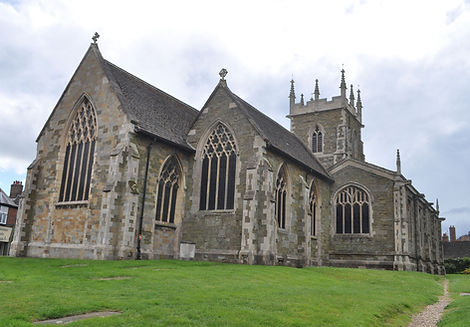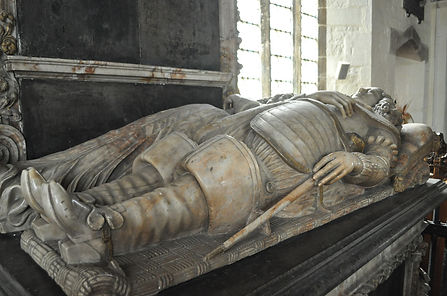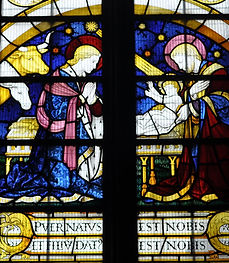FOLKINGHAM & ALFORD
FOLKINGHAM : CHURCH OF ST ANDREW
Church Post Code NG34 0SD
South aisle open to visitors
Visited June 2020
The three month UK lockdown had ended, and churches were allowed to open again, either for private prayer, or for the brave few, public worship. Things had improved and there was a real desire to try and regain some semblance of normality again. Infection and death rates were still high though, and there was regular talk of a potential second wave, and what the effects would be. This is being typed during the second English lockdown, in November 2020, so those fears were justified.
Personally, I had been very fortunate. I work for myself as a gardener and my profession was allowed to work under strict guidelines. Therefore, I had pretty much avoided being locked down but was still keen to get on the road again, just for a change of scenery and to do what I love to do, but to do it legally and safely as possible,
The original plan was to head in to Rutland, and to spend the afternoon re-visiting a few churches in that glorious county. However, a fairly drastic last second change of plan saw Gary and myself head out towards the Lincolnshire coast.
On the journey there, the discussion was, what we should expect to find. Personally, I was expecting to find most of the churches closed but my heart was hoping to find most of them open. My thought process was that many people would be struggling through very challenging times. Church doors should be open for anyone who needed some peace and calm in their lives. Whether that be congregation members, non believers or visitors just looking to enjoy the beauty of the place and find some calm in the storm. Just to sit and be at peace.
Whilst appreciating that it would be difficult for some people, people at risk due to age or illness, to want to come out and open up, I really hoped that someone would as, in my opinion, it was more important for the churches to be open now than at any point in this country’s recent history. As a practicing Christian it didn’t sit well with me that church doors would be closed when many would wish them to be open!
First church visited was a re-visit. I have a great love for the church of St Andrew, Folkingham. My first visit here was back in 2008, on a week long cycling churchcrawl of the area. Fond memories of standing on high ground, looking at this church a mile or so distant, thinking something doesn’t look right! Something definitely wasn’t right. Two pinnacles were missing, taken down in gale force winds. Well, they weren’t missing as such, with one having fallen through the roof and ending up in the nave. The church was still open that day, the hole in roof covered with blue tarpaulin and rubble from the pinnacle still covering the floor.
The beautiful perpendicular church of St Andrew has origins back to the 12th century, with the building that we see today mainly from the 15th century. The church is set back a little from the market square, with the main road running close by, connecting Bourne and Sleaford. The lane that leads to the church contains some delightful old cottages. A lovely scene!
St Andrew has a reputation of being open and welcoming. Pinnacle crashing through roof doesn’t close it and neither does pandemic! The door of the two storey south porch was open and the sign greeting visitors stated “you are welcome in this church please take care”. First church visited in three months, thank you for being open. There were restrictions inside, with just the south aisle and a part of the west end being open for personal prayer.
The majority of the photographs on this page are from this June 2022 visit, but I have added a few interior shots from a previous visit to give a better flavour of the interior of this beautiful church.
Moving inside, this is a church of impressive proportions. The north and south aisles are each of three bays, with each dating from the 14th century. They have octagonal piers and capitals. Nave is separated from chancel by a fine screen which dates from around 1330. The chancel arch itself is late 13th century. Looking to the west; the tall, slim, elegant tower arch dates from 1435.
The church here has some fine stained glass, but nothing of any great age with the exception of three medieval glass roundels which have been reset in to a window in the north aisle. The east window is of four lights and contains four scenes from the life, and death of Christ. From left to right we have the nativity followed by the crucifixion. This depiction veers from the traditional somewhat as it shows Mary, the mother of Jesus passed out by the side of the cross, being attended to by John. Mary Magdalene weeps in her usual place at the foot of the cross.
The third panel shows the scene on Easter morning with an angel of the Lord appearing to the three Mary’s outside the empty tomb ‘He is not here He is risen’. Finally we have the ascension; with all four scenes being watched over by angels.



Moving back outside and looking up, we see a humorous gargoyle, grimacing and looking to be in urgent need of the toilet; a downspout strategically placed to give some relief when it rains.
A couple on interesting gravestones caught the eye. Carved in slate a stone in memory of Mary Gibson who died suddenly in 1831 has the remarkable inscription ‘Unceremonious Doom. The thunderclap was heard, the bolt was felt before t’was heard, such was the will of Heaven’.
Another stone shows the gravediggers tools of pick and shovel, both images of the mortality of Man; along with a serpent with its tail in its mouth. This is an Ouroboros, a symbol for eternity. This reads as eternity in the midst of death’ a testament as to the faith of the deceased.
ALFORD : CHURCH OF ST WILFRID
Church Post Code LN13 9DS
Open to visitors


After visiting one or two other churches locally, we headed off north east. The main reason for deciding to head this way was to see the church at Alford; in a delightful market town on the edge of the Lincolnshire Wolds, and seven miles from the east coast. The church of St Wilfrid sits on slightly high ground in the middle of the town, the busy main road ruining past the church on its way to Mablethorpe. It was lovely to find this church open. According to the notice board, the church was open for private prayer two days a week. According to the church website, the church was open every day for private prayer during the November lockdown.
There was hand sanitiser on entry but unrestricted access throughout the church. It was lovely to wander around the interior, enjoying the church and the silence; with no noise coming in from the busy main road just a few yards away.
The church here dates from the mid 14th century in to the 15th century, with Victorian restoration by George Gilbert Scott in 1867. This church stood on the site of a previous structure which was pulled down around 1350.
The structure that we see today consists of west tower, nave with north and south aisles, plus additional north aisle, north chapel, south porch and chancel.
The west tower was rebuilt between 1525 and 1535; the north chapel was founded in 1396, with the additional north aisle being a Victorian addition, added at the time of Scott’s restoration. The two storey 15th century south porch has a room above, a parvise, which was used as a grammar school from 1566.





Moving inside, as with Folkingham, this is a church of impressive dimensions, telling of the wealth here when this church was built. There are four bay arcades to north and south, with these dating from the 14th century. The additional north arcade is also of four bays, matching the other two. The chancel is separated from nave by a screen from the late 14th century, with a modern rood above. The chancel arch dates from the Victorian restoration; looking to the west the tower arch is 16th century.


Against the south wall of the chancel there is a fine mid 17th century monument to one Robert Christopher. He and his wife lay recumbent, facing the altar, he wearing armour and with hand on heart. Both are depicted with long flowing hair. Unusually, he is depicted with what is either a walking stick or swagger stick at the side of him. I am not sure if swagger sticks, used as a symbol of authority, were around in the 17th century. If it is a walking stick then it is very unusual for the deceased to be depicted with any infirmity. Thoughts turned to Ingoldmells a few miles away, where a figure on a monument is portrayed with crutch!
There is some fine stained glass here. The fine five light east window depicts ten scenes from Holy Week and is courtesy of Ninian Comper. Other glass shows the restoration of Peter after he denied knowing Christ three times of the night of his arrest. There is also a fine depiction of the Annunciation with the golden haired, golden robed angel Gabriel pointing upwards towards Heaven. Script along the bottom reads ‘Hail thou that art highly favoured the Lord is with thee. The Holy Spirit, in the form of a dove shines down on Mary, with white lilies nearby symbolising purity.
Another three light window shows Sir Galahad, who is flanked by St George, with Dragon trod underfoot and St Michael, who carries the scales on which the souls will be weighed on the final day. Satan is trodden underfoot by St Michael; this referring to Revelation Chapter 12 where St Michael does battle with Satan and casts him out.





As we left Alford it was clouding up and the promised storms were fast approaching. As mentioned at the start of this piece, this was the first trip out after the first covid three month lockdown had been lifted. As the rain started we decided to abandon the photography for the day and take a drive out through Mablethorpe and Skegness, to see how things were looking in what would, in previous years, have been a very busy time. It was depressing! Just a few people on the streets and a few shops open. We drove through in near silence; this was hard to see to be honest! We headed back towards home, alternating between brilliant sunshine and torrential rain. It was good to be able to travel again!









